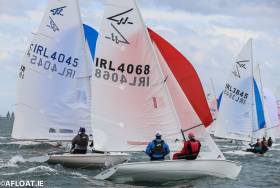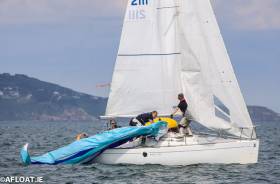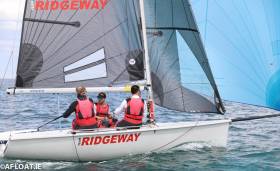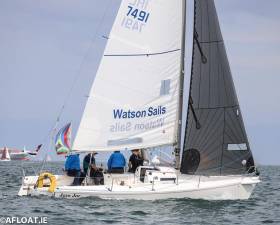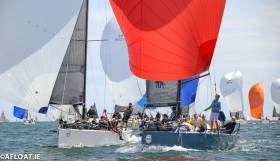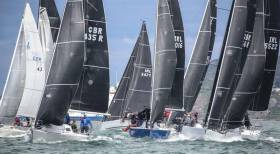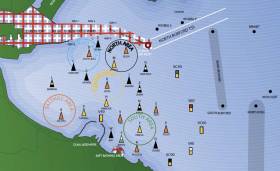Displaying items by tag: Dun Laoghaire Regatta
In one of the biggest one design fleets of the massive 500-boat of Volvo Dun Laoghaire Regatta, John O'Sullivan's Rhubarb leads the Flying Fifteens after two races.
In some neat sailing on the Salthill Course, O'Sullivan of the National Yacht Club scored a 1 and a 4 to lead club mates and FF National Champions David Gorman and Chris Doorly but they are tied on the same 5 points in the 24-boat fleet. Third is Peter Murphy in Hera, also from the NYC.
The One Design keelboat class is in warm-up mode for its Subaru-sponsored World Championships that will be staged on Dublin Bay in two months time.
Racing continues on Friday.
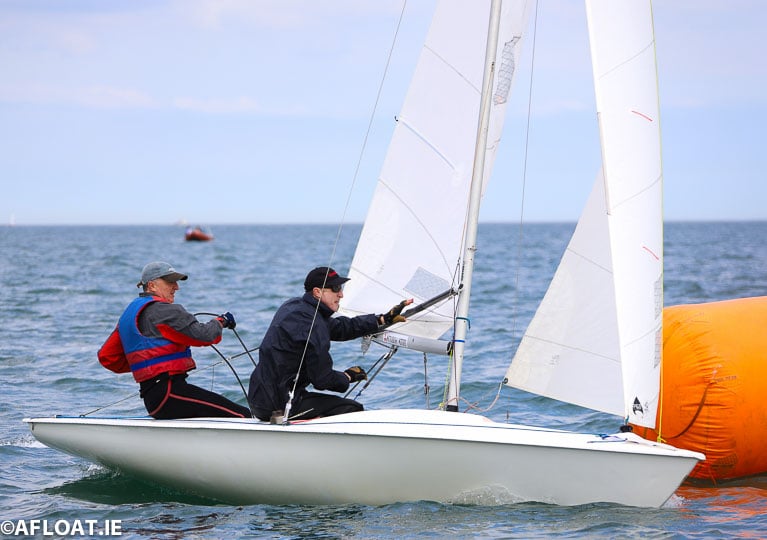 Tom and Eamonn Galvin lead at the first mark of Race Two Photo: Afloat
Tom and Eamonn Galvin lead at the first mark of Race Two Photo: Afloat
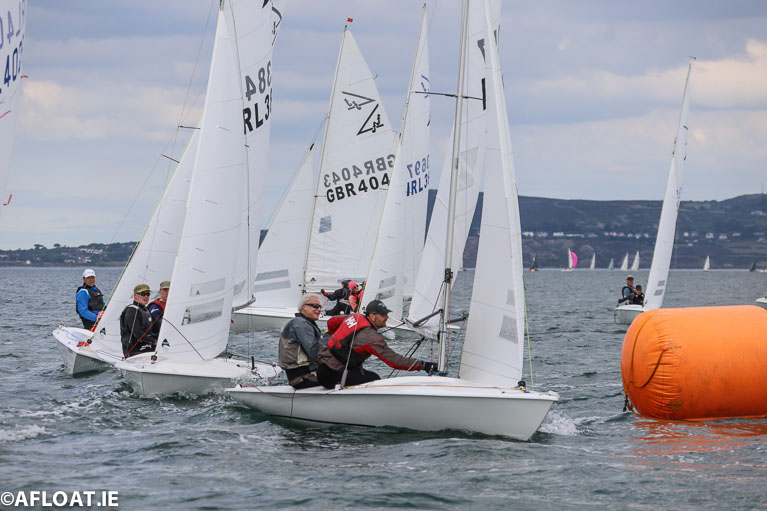 Tom Murphy and Carel La Roux lead a bunch of boats at the weather mark Photo: Afloat
Tom Murphy and Carel La Roux lead a bunch of boats at the weather mark Photo: Afloat
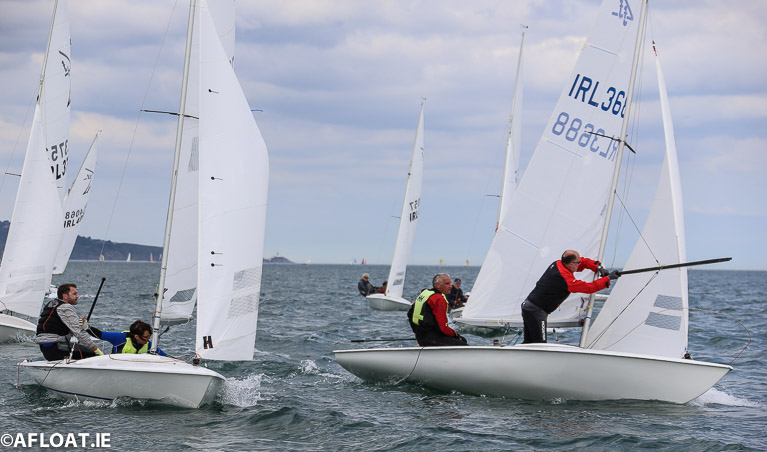 Ben Mulligan and Cormac Bradley set the pole Photo: Afloat
Ben Mulligan and Cormac Bradley set the pole Photo: Afloat
 DMYC's Neil Colin at the front of a pack of FFs downwind Photo: Afloat
DMYC's Neil Colin at the front of a pack of FFs downwind Photo: Afloat
None other than Mark Mansfield predicted that the Scottish Series would prove an important warm-up for Irish raiders, and it certainly seems to be the case for Beneteau 31.7 owner John Minnis.
The Royal Ulster sailor struggled to make an impact at Tarbert in an IRC3 class dominated by the upgraded Half Tonners of Johnny Swan and the Wrights of Howth.
But in this week’s standalone Beneteau 31.7 class, his ‘Final Call’ crew finished Day 1 of the Volvo Dun Laoghaire Regatta at the top of a 14-boat fleet.
‘Crazy Horse’ duo Frank Heath and Ivan Schuster, who finished third in the National Championships on the same waters 11 months ago, couldn’t take up the invitation that was staring them in the face at the Race 1 finish line.
Royal St George’s Michael Blaney finished ahead of them in second place at the helm of ‘After You Too’.
First 211s
Meanwhile the bijou Beneteaus - the First 211s - were engaged in the opening round of their Irish Championships.
Andrew Bradley’s ‘Chinook’ and Scottish duo Stu and Deb Spence were narrowly beaten to the title during VDLR17.
Two years on and rivalry between the Royal Irish and Clyde Cruising Club boats is just as keen.
But again they find themselves chasing first place, which this time is being held by Pete and Anne Evans on their Greystones entry, Anemos 2.
After an opening race win in the Volvo Dun Laoghaire Regatta SB20 Division today, the All-Ireland Sailing Champion Peter Kennedy helming Team Ridgeway could only manage sixth in the second race to place third overall in the 16-boat sportsboats fleet.
The lead is held by Jerry Dowling's Bad Kilcullen who scored 3, 1 In May, the on-form Dowling crew also won the class Northern title on Strangford Lough. Second overall is Alert Packaging, (Chris Helme, Justin Burke & Alan Claffey) of the National YC on five points.
The 16-boat turnout at Dun Laoghaire is a shot in the arm for the class that last month was forced to cancel its Sprint Series due to lack of numbers.
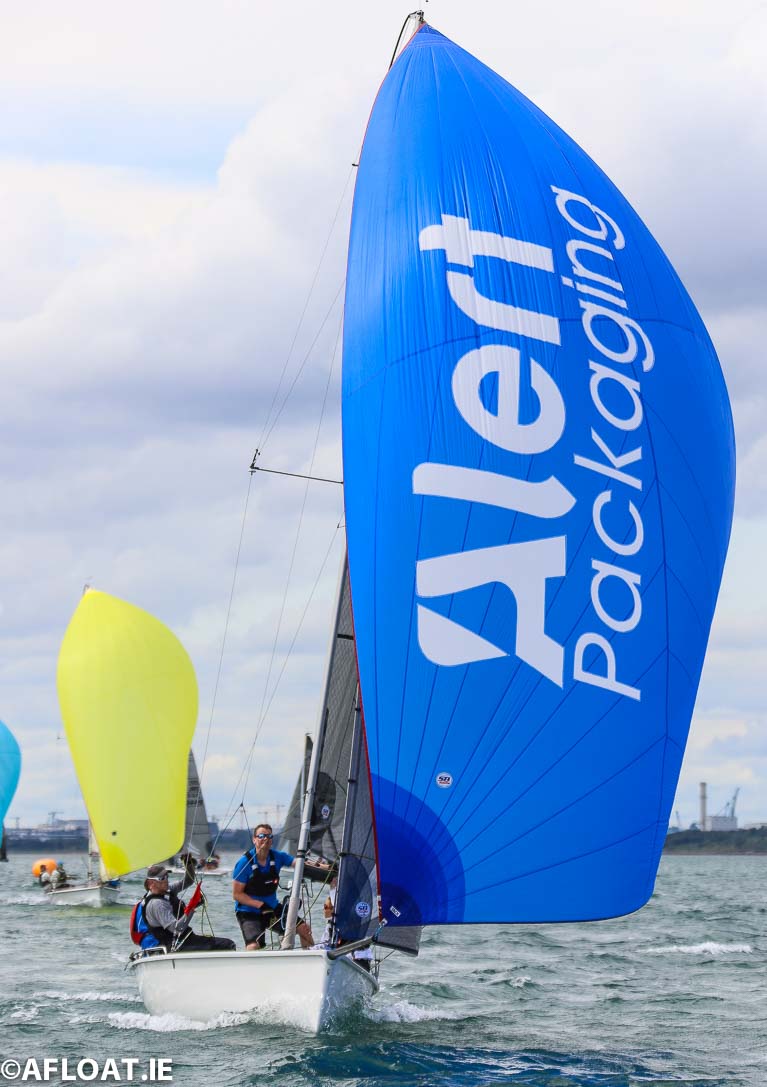 Justin Burke's Alert Packaging lies second Photo: Afloat
Justin Burke's Alert Packaging lies second Photo: Afloat
First round in the Volvo Dun Laoghaire Regatta battle of the sportsboats was won decisively by the 1720s - and the Royal Irish.
David Ryan’s 'Big Bad Wolf' took the first bullet in a mixed series that is being fought out by a 22-strong fleet.
And waterfront clubmate Ian Cummins worked his magic in 'Merlin' - avoiding a repeat of her fate in the 1720 East Coast championships to take second place.
Former Helmsman Champion Robert Dix has been tipped to shine among the J80 fleet this week, but the veteran competitor couldn’t make his experience tell in the light and shifty airs of Dublin Bay's northern reaches.
Instead, it was Howth sailmaker Philip Watson who salvaged some honour for the class in 'Jam Jar', pipping Conall O’Halloran’s 'Jitterbug' for third.
Royal St George sailor Conall fared better in the standalone J80 event, topping the Day 1 league table ahead of Annemarie Murphy’s National crew in 'Jay Z' and the Howth-based 'Red Cloud', helmed by Norbert Reilly.
It was ultra-high summer, and it was difficult sailing in Dublin Bay for the hugely varied fleet starting their racing in the Volvo Dun Laoghaire Regatta 2019 writes W M Nixon. Today’s opening racing started with so much promise – a sparkling sunlit westerly and the race area enlivened by the flood tide. But as the afternoon settled in, the breeze went to sleep, and when a new easterly finally decided to come creeping in under a soft grey sky, it did so in a very uneven way, as was shown in the results for the IRC Classes.
For although the glamour boats of Classes 0, 1 and 2 were in the Race Area nearest the smooth opulence of Dublin Bay’s southeast coast, it was the smaller craft exiled to the middle of the bay – virtually the Northside as some true blue Dun Laoghaire types saw it – who had the best of the day’s sailing, as the new wind nipped in round the Baily with some determination, whereas it was decidedly languid as it wandered in past the Muglins and Dalkey Island.
 The J109 Outrajeous is the first to set her kite on the opening 'beat' when the wind shifts just minutes into race one. The race was abandoned. Photo: Afloat
The J109 Outrajeous is the first to set her kite on the opening 'beat' when the wind shifts just minutes into race one. The race was abandoned. Photo: Afloat
In other words, the biggies completed just one race, but the little ‘uns got in two. In Class 0, Jamie McWilliam’s Ker 40 Signal 8 from Hong Kong looked like she could fly given a wind, but for some time there weren’t no wind at all at all to ruffle the hair-styles of Dalkey, and it was Frank Whelan’s achingly consistent Grand Soleil 44 Eleuthera from Greystones which started from where she’d left off at Kinsale by taking the bullet, while second went to Conor Phelan’s Ker 36 Jump Juice from Crosser, but Signal 8 still made the podium with the third.
 Jamie McWilliam's Ker 40, Signal 8 Photo: Afloat
Jamie McWilliam's Ker 40, Signal 8 Photo: Afloat
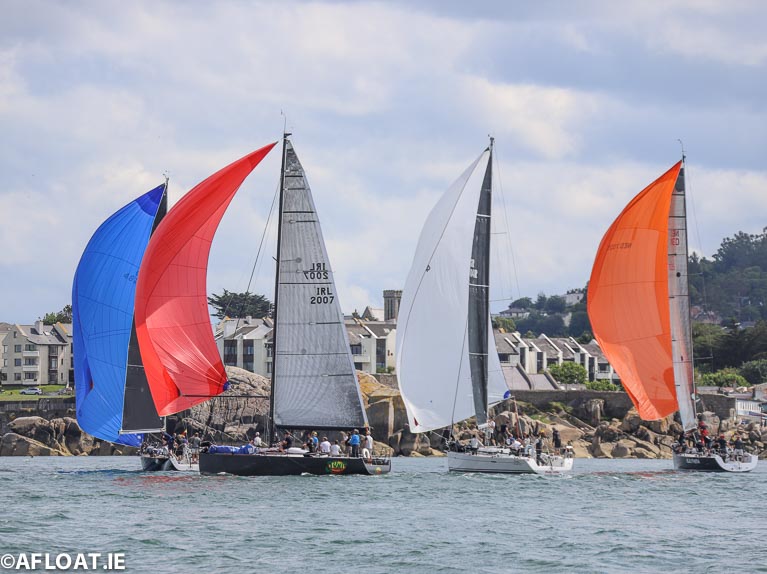 A tightly grouped Class Zero off Bulloch Harbour just before the wind died in aborted race one Photo: Afloat
A tightly grouped Class Zero off Bulloch Harbour just before the wind died in aborted race one Photo: Afloat
IRC 1 was a truly awesome turnout in terms of number, but as far as wind speeds were concerned, the numbers suited the J/109s very well indeed, thank you, and they took eight of the first ten places, with the John Maybury’s Joker 2 (RIYC) getting the best of it from clubmates Tim & Richard Goodbody in White Mischief, third place going to Pat Kelly’s Storm from Howth and Rush while longtime J/109 advocates Brian & John Hall (NYC) were fourth with Something Else.
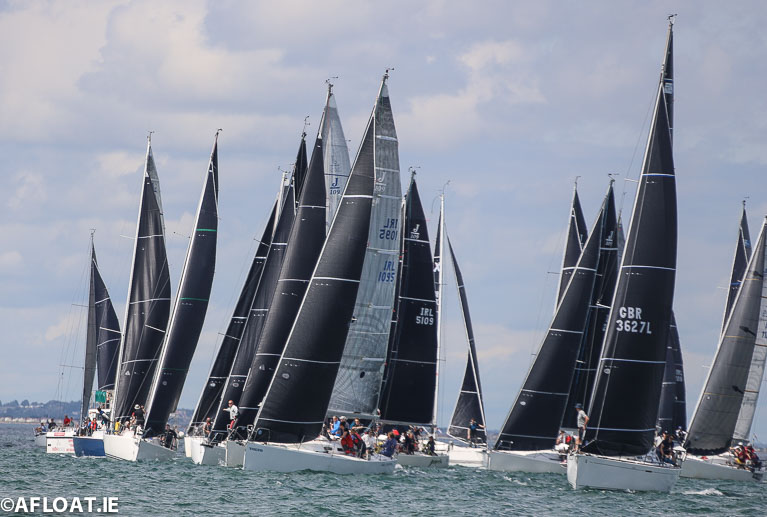 A Class One Start Photo: Afloat
A Class One Start Photo: Afloat
The RC 35 Division was within IRC 1, and here the winner was Storm with Something Else second and Robin Young’s Jings from Scotland – yet another J/109 – taking third.
Coastal Division
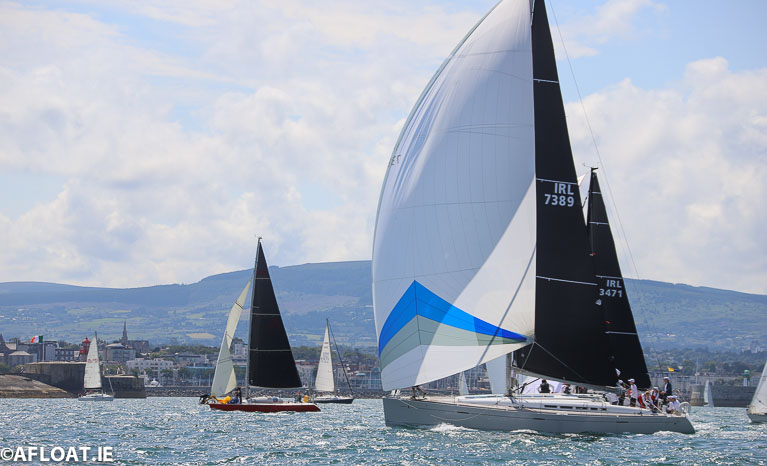 Seamus Fitzpatrick’s big Beneteau First 50 Mermaid IV clears the harbour mouth at the start of the race Photo: Afloat
Seamus Fitzpatrick’s big Beneteau First 50 Mermaid IV clears the harbour mouth at the start of the race Photo: Afloat
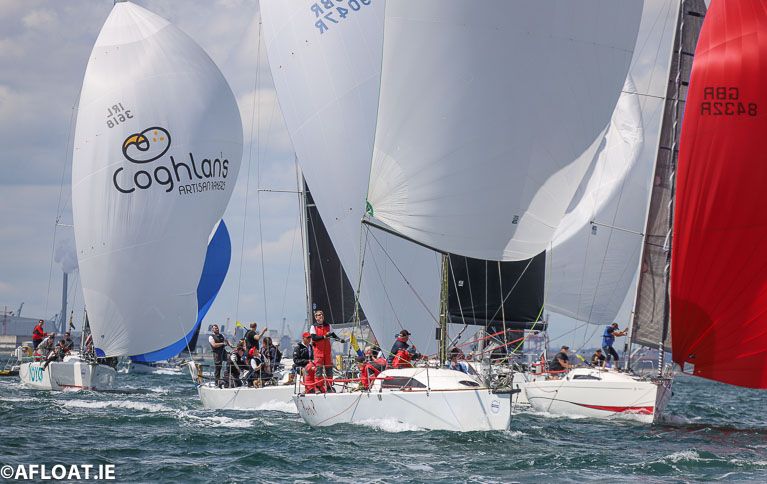 The start of the coastal class race with Fintan Cairns's Raptor closest to camera Photo: Afloat
The start of the coastal class race with Fintan Cairns's Raptor closest to camera Photo: Afloat
Meanwhile the 30 boats which had gone offshore in the coastal race finally managed to find their way to a finish, and it was Seamus Fitzpatrick’s handsome big Beneteau First 50 Mermaid IV (RIYC) – with former All-Ireland Sailing Champion Ben Duncan as tactician - which managed to stave off the challenge of Andrew Hall’s slippery J/125 Jackknife from Pwllheli in second, third place going to George Sisk (RIYC) with his Xp44 WOW.
 JackKnife follows Wow out of Dublin Bay at the start of an 18-mile coastal race Photo: Afloat
JackKnife follows Wow out of Dublin Bay at the start of an 18-mile coastal race Photo: Afloat
By comparison with the frustrated big fellows, IRC 3 out in mid-bay had themselves a heady time of it with two races completed, and it was Charlie McAllister’s Starflash Quarter Tonner Fait Accompli from Antrim Boat Club on Lough Neagh which took to the salty sea with relish, and emerged top of the day’s racing with a 1st and a 3rd, Ger O’Sullivan’s Formula 28 Animal from Howth being next best with a 5th and a 1st, while third overall was taken by Ken Lawless’s Quarter Tonner Cartoon (RIYC) with a 4th and 2nd.
Perhaps the most impressive aspect of the IRC racing is the sheer size of the class numbers involved. If the fates decide to give us enough breeze tomorrow to provide racing, we’ll look in more detail at some other sides to this varied and complex story. But for now, the miracle is that with the awkward wind pattern, the Race Officers still managed to get in a programme, we have results, and tomorrow is another day.
Division 2a details are here
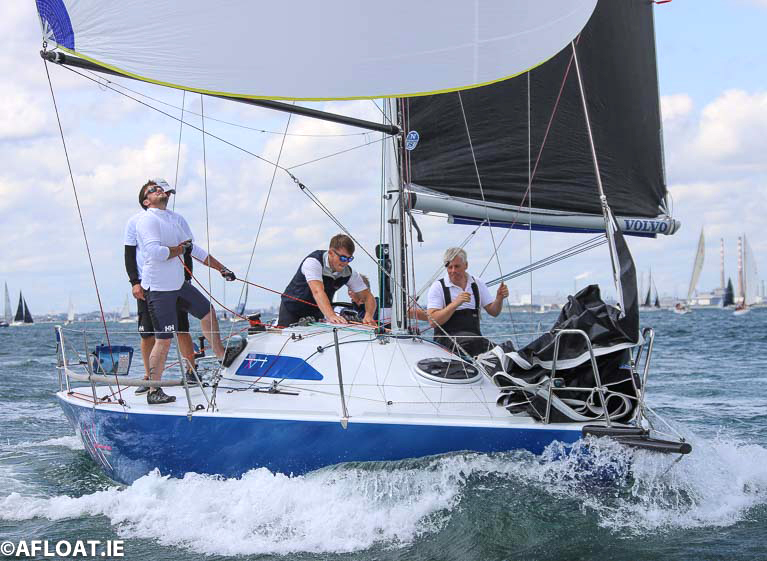 Dave Cullen's Checkmate XV is competing in class Two Photo: Afloat
Dave Cullen's Checkmate XV is competing in class Two Photo: Afloat
There is no doubt about it that 500 entries – so far – for Thursday's Volvo Dun Laoghaire Regatta is a great indication of the state of yacht racing in Ireland, especially when so many other regattas struggle for numbers.
There are six IRC spinnaker classes bucking this trend plus a further 27 One Design and White Sail classes competing, making up this massive 500–boat fleet.
Download the Class Splits for Dun Laoghaire Regatta's IRC Classes below as a PDF file.
Based on these divisions, Afloat takes a shot at naming some likely winners in each of these six IRC classes. At the Sovereigns Cup in Kinsale, a fortnight ago, we did likewise and were successful in three of our four IRC class picks.
Light Wind Forecast
Weather conditions, as always will have a big bearing on who wins, with some designs clearly favouring lighter winds and some strong winds. With three days to go, it is possible to get a fairly decent steer of what the wind conditions will be like. It appears Dun Laoghaire Regatta 2019 will be a very light air affair unless some thermal winds appear, but with cloudy conditions expected for three of the four days, the chances of these thermals coming in are lessened. Therefore our picks for likely winners take this into account.
Offshore Class—28 Entries
In reality, though officially described as an 'Offshore' Class, it is effectively a 'Coastal' Class.
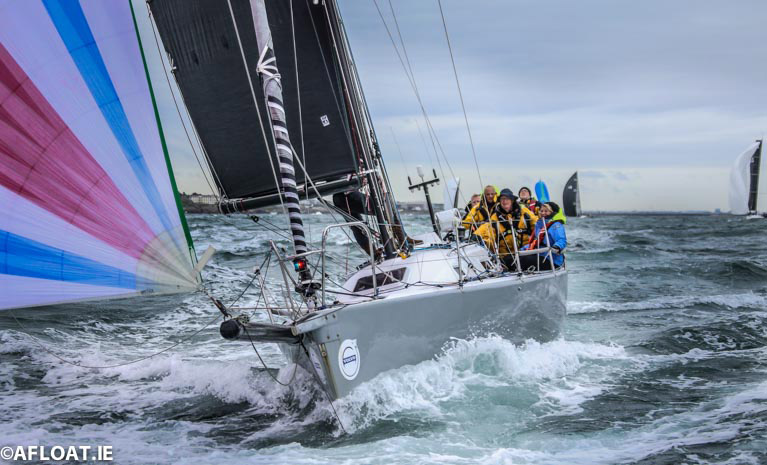 Jackknife, the J125 of Andrew Hall from Pwllheli Sailing Club
Jackknife, the J125 of Andrew Hall from Pwllheli Sailing Club
Jackknife, the J125 of Andrew Hall from Pwllheli Sailing Club is leading the ISORA Series overall and is a potent performer, particularly when she can get planing. Likewise, the two Jeanneau Sunfast 3600s from Dun Laoghaire, Yoyo (Brendan Coughlan) and Hot Cookie (John O'Gorman). Hot Cookie had an impressive third place overall result at the recent Dun Laoghaire to Dingle Race, while Yoyo features well also on the ISORA Circuit.
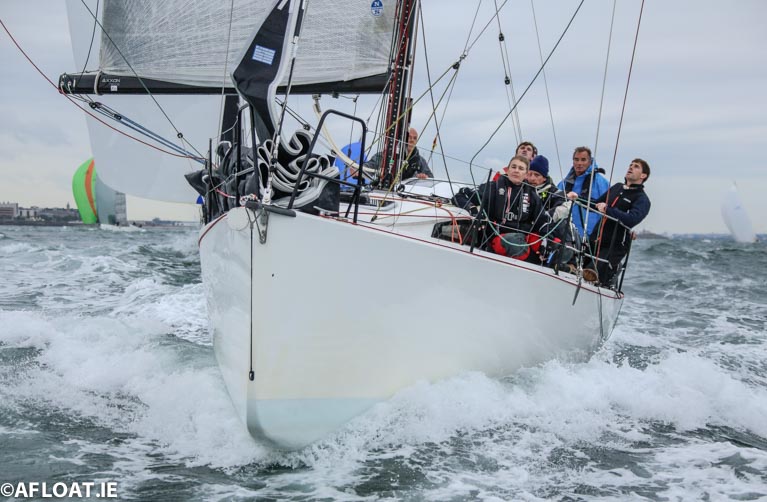 Paul O'Higgins's Rockabill VI from the Royal Irish Yacht Club
Paul O'Higgins's Rockabill VI from the Royal Irish Yacht Club
Paul O'Higgins's Rockabill VI from the Royal Irish has already won D2D overall and the Coastal class at ICRAs but may not like the light air conditions much. Even still, she will compete hard and if a bit of breeze builds, she will perform well.
 George Sisk's new XP44 WOW from the Royal Irish Yacht Club
George Sisk's new XP44 WOW from the Royal Irish Yacht Club
All these boats will need some breeze and some good reaching conditions to shine. George Sisk's new XP44 from the Royal Irish took a clean sweep in the Coastal Class at the Sovereign's Cup just two weeks ago and is known to be particularly swift in light airs. In addition, she seems to possess a good selection of offwind sails, so she must be the favourite for this class. The two boats that might upset this, however, are the J109’s, Jaydreamer, owned by Paul Sutton from Liverpool, Peter Dunlop's Mojito from Pwllheli and Nigel Ingram's Jetstream from Holyhead. The J109 is a particularly potent performer in light airs, and with their asymmetric spinnakers will likely be well suited for this class.
Class 0: Six entries
The Offshore Class has pulled many of the larger boats, leaving just the hardcore of top IRC big boats here.
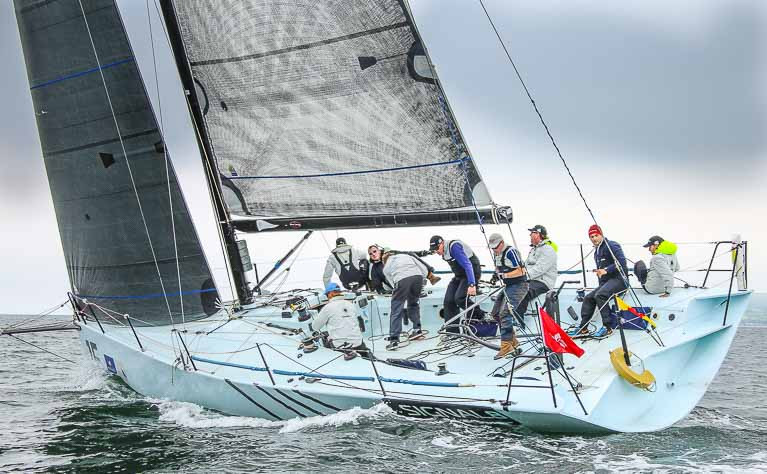 Jamie McWilliam's Signal 8, a Ker 40, sailing under the burgee of the Royal Hong Kong Yacht Club
Jamie McWilliam's Signal 8, a Ker 40, sailing under the burgee of the Royal Hong Kong Yacht Club
The highest rated will be Jamie McWilliam's Ker 40, Signal 8 from Hong Kong. Signal 8 won last years Wave Regatta at Howth in light airs, from Jump Juice from Royal Cork owned by Conor Phelan. Jump will be in the mix this year as well.
 Jay Colville's First 40, Forty Licks from East Down Yacht Club
Jay Colville's First 40, Forty Licks from East Down Yacht Club
Jay Colville's First 40, Forty Licks from East Down Yacht Club always performs well in all conditions, and will likely finish in the top three, as likely will Jonathan Anderson's J122e from the Clyde.
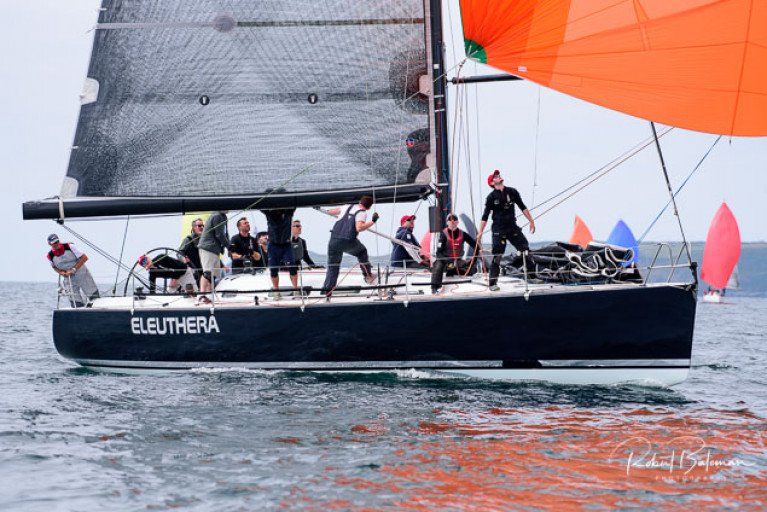 Frank Whelan's Grand Soleil 44, Eleuthera from Greystones Photo: Bob Bateman
Frank Whelan's Grand Soleil 44, Eleuthera from Greystones Photo: Bob Bateman
For the overall win, however, you cannot go beyond Frank Whelan's Grand Soleil 44, Eleuthera from Greystones. Second at the ICRAs and a clear winner at the Sovereign Cup last month, she is a noted light air performer, and with Shane Hughes from North Sails aboard, must be the bookies favourite in this class.
Class 1: 27 entries
This is likely to be the most competitive and hardest class to pick a winner this year. The normal Irish and Welsh boats in this class will be joined by the Scottish RC 35 Class who are using Volvo Dun Laoghaire Regatta as one of the Celtic Cup events, so six of this class have travelled to the hub of Irish Sea yachting.
16 x J109s feature in this class and are known to be potent in light airs, so it is likely that two or three of the podium results will go to a J109. So far this year, a J109 has won the Scottish Series, the ICRAs and the Sovereign's Cup, in varying conditions.
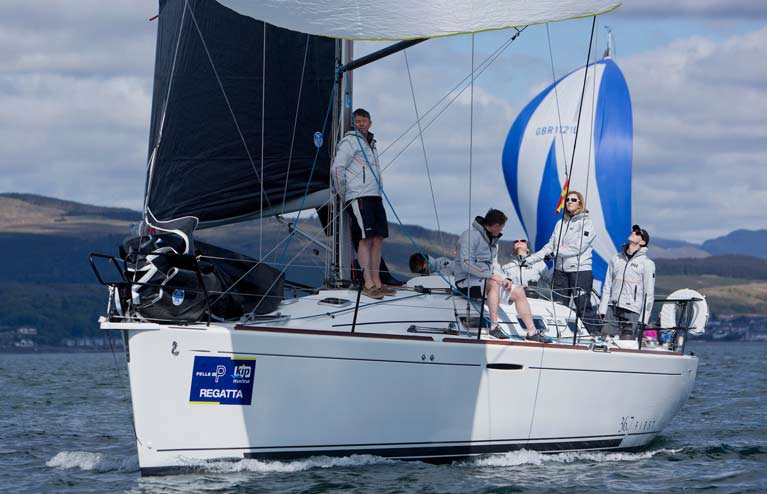 Kevin and Debbie Aitken's Beneteau 36.7, Animal, from the Clyde
Kevin and Debbie Aitken's Beneteau 36.7, Animal, from the Clyde
Apart from the J109s, there are a few others that will feature. If it stays light for all four days, Kevin and Debbie Aitken's Beneteau 36.7, Animal, from the Clyde is a potent performer in light airs and has already won the RC35 Class Nationals this year. One windier day, however, could be her undoing as if she cannot keep up with the J109’s on a moderate day, she will end up with a couple of high numbers. This is what happened at the Scottish Series back in May.
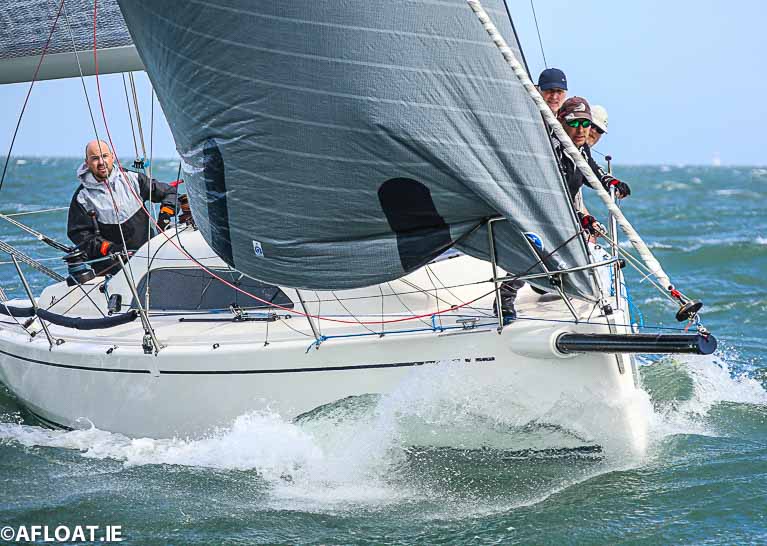 Colin Byrne's Xp33, Bon Exemple from the Royal Irish Yacht Club
Colin Byrne's Xp33, Bon Exemple from the Royal Irish Yacht Club
Colin Byrne's Xp33, Bon Exemple has been going particularly well in Dublin Bay Sailing Club racing until she had to do some mast repairs. She is a great all-round boat and will be to the front of the fleet. Andrew Algeo's new J99, Juggerknot 2 from the Royal Irish has shown some flashes of speed and will likely be in the mix.
 Andrew Algeo's new J99, Juggerknot 2 from the Royal Irish Yacht Club
Andrew Algeo's new J99, Juggerknot 2 from the Royal Irish Yacht Club
Getting back to the J109s, the four that took the top four results at this year's ICRAs are all back, and all have good tacticians aboard. John Maybury's Joker 2, From the Royal Irish, who was the 2017 Dun Laoghaire Regatta winner will have Olympian Killian Collins aboard. Jelly Baby, owned by Brian Jones from the Royal Cork has Killian's brother Mel on tactics. Storm 2, owned by the Kelly family from Rush has North Sails Nigel Young aboard, and Outrajeous, owned by John Murphy and Richard Colwell from Howth, has Olympian Mark Mansfield aboard. Outrajeous just won the Sovereigns Cup two weeks ago in Kinsale. Other top J109s likely to do well will be Tim Goodbody's locally-based White Mischief from the Royal Irish, Brian and John Hall's Something else from the National Yacht Club and Andrew Craig's Scottish Series winner, Chimaera from the Royal Irish.
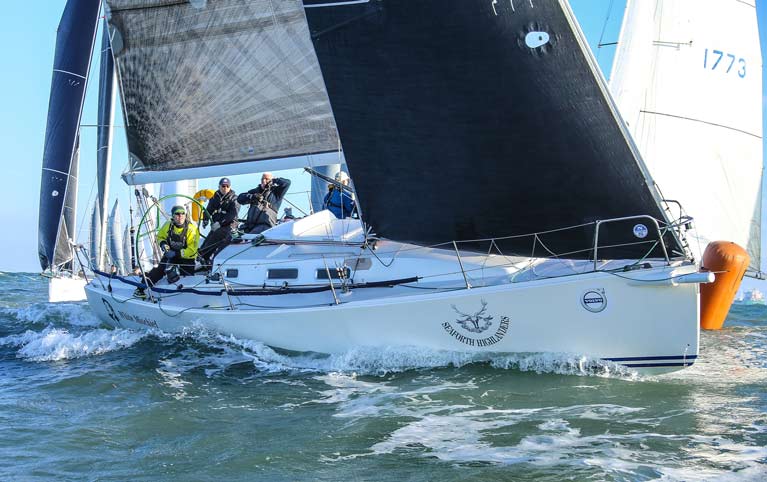 Tim Goodbody's J109 White Mischief from the Royal Irish Yacht Club
Tim Goodbody's J109 White Mischief from the Royal Irish Yacht Club
 Brian Jones's J109 Jelly Baby from Royal Cork Yacht Club
Brian Jones's J109 Jelly Baby from Royal Cork Yacht Club
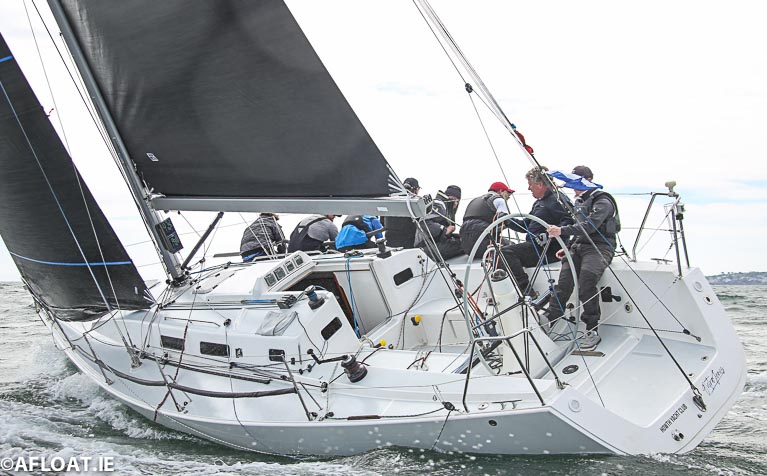 Outrajeous, owned by John Murphy and Richard Colwell from Howth
Outrajeous, owned by John Murphy and Richard Colwell from Howth
Who to pick from this lot? Were it moderate conditions, it likely would be Outrageous, Joker 2 and Storm to fight it out. However, both Storm and Outrageous have opted for symmetrical spinnaker configuration this year and in light airs an asymmetrical spinnaker has an advantage. As a result, we suggest Joker 2 will take it by a nose.
Class 2: 23 entries
Were it moderate conditions we could talk about one of the J97s having a good chance, or perhaps Anthony O'Leary's converted 1720, Antix Beag, from Cork or the newly crowned ICRA Class Three champion, the X302 Dux (Anthony Gore Grimes) from Howth.
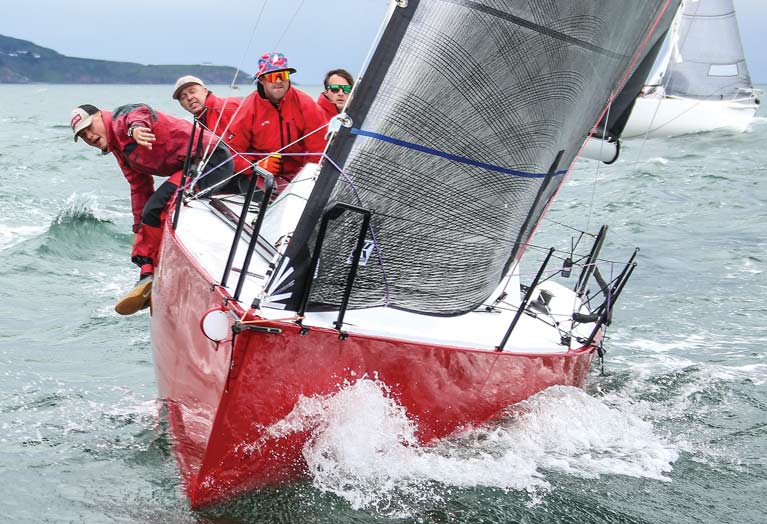 Anthony O'Leary's modified 1720, Antix Beag, from Cork
Anthony O'Leary's modified 1720, Antix Beag, from Cork
However in light airs, the modernised Half Tonners are flyers and so, one of these five must be likely to take the spoils.
The Wright brothers Mata from Howth has won the ICRAs this year and also won the Irish Half Ton Cup at the Sovereigns Cup. She has been going particularly well, but unlike the other events, she does not have a pro for this regatta.
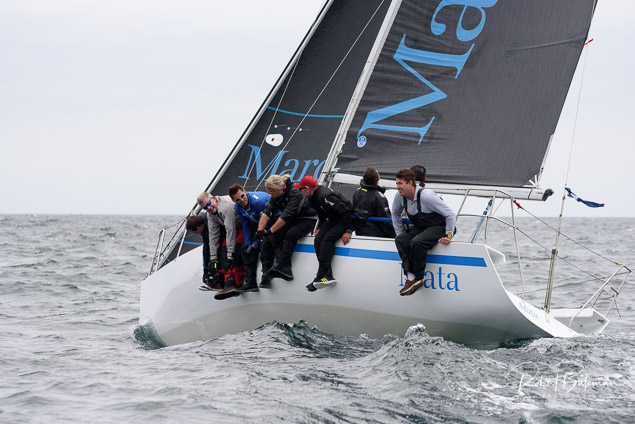 The Wright brothers Mata from Howth Photo: Bob Bateman
The Wright brothers Mata from Howth Photo: Bob Bateman
Nigel Biggs's Checkmate XVIII from Howth won her class in Sovereigns and was close also at ICRAs. Her tactician, Neil Mackley from North Sails, will, Afloat understands, be with her again for Dun Laoghaire Week and this must make her one of the main contenders.
 Nigel Biggs's Checkmate XVIII from Howth Photo: Bob Bateman
Nigel Biggs's Checkmate XVIII from Howth Photo: Bob Bateman
Finally, Dave Cullen from Howth has not featured of late in his champion Half Tonner, Checkmate XV. For this event, he has brought in well known one design pro, Ruairidh Scott from the UK to call tactics and this will likely bring him well into contention. So, it likely will be between these three. We will tip Nigel Biggs to take it from Dave Cullen, but it will all be pretty close.
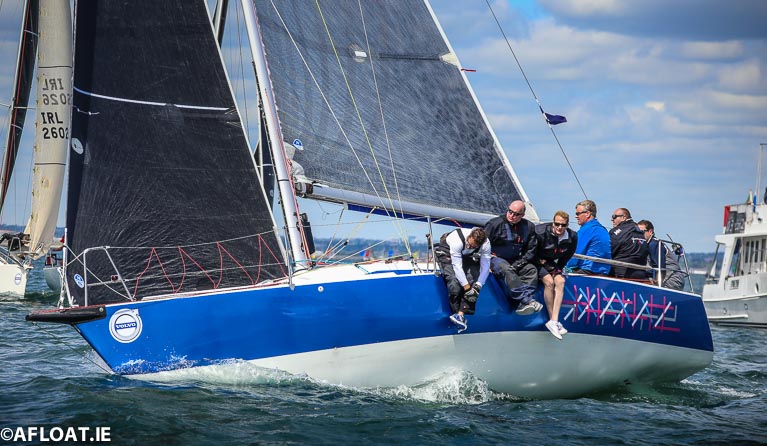 Dave Cullen's Half Tonner, Checkmate XV from Howth
Dave Cullen's Half Tonner, Checkmate XV from Howth
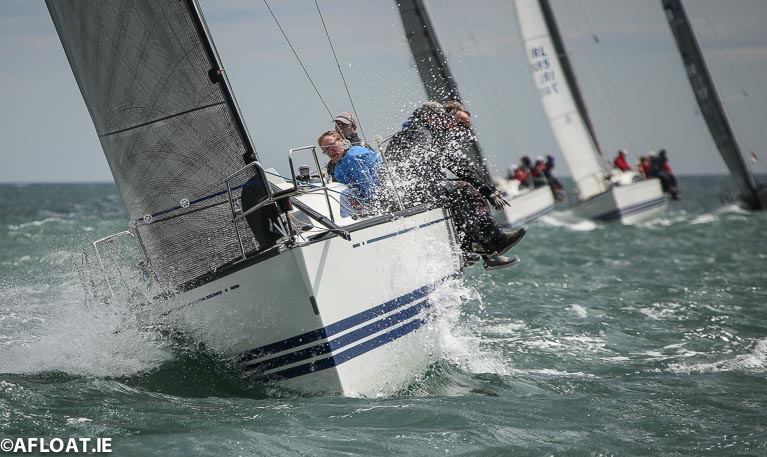 ICRA champion X302 Dux (Anthony Gore-Grimes) from Howth
ICRA champion X302 Dux (Anthony Gore-Grimes) from Howth
Class 3: 19 entries
Were it moderate to fresh, the four J24s would likely be in the frame. The Quarter Tonners, however, love this light stuff and chief among them will likely be Ken Lawless and Sybil McCormack's Cartoon from the Royal Irish. Other Quarter Tonners that will like the conditions will be Paul Colton's Cri Cri from the Royal Irish and John Hasson and Neil Doherty's Panic from Lough Swilly Yacht Club.
 Paul Colton's Cri Cri from the Royal Irish Yacht Club
Paul Colton's Cri Cri from the Royal Irish Yacht Club
 FNGr8, the optimised First Class 8 skippered by Rory Fekkes from Carrickfergus Sailing Club
FNGr8, the optimised First Class 8 skippered by Rory Fekkes from Carrickfergus Sailing Club
Brendan Foley's highly optimised Impala, Running Wild from the Royal St George, complete with fat head main, will also love these light airs. Finally, runner up to Dux at the ICRA Nationals this year was FNGr8, the optimised First Class 8 of Rory Fekkes from Carrickfergus Sailing Club. Rory won his class easily at the Scottish Series and was overall winner at 2018 Cork Week. We will tip him to add a Volvo Dun Laoghaire Regatta crown to these titles, likely with Cartoon or Running Wild in second.
 Brendan Foley's highly optimised Impala, Running Wild from the Royal St George Yacht Club
Brendan Foley's highly optimised Impala, Running Wild from the Royal St George Yacht Club
Class 4: 16 entries
Hard to know who will take this one. Philip Dwyer's Supernova, who won his class at ICRAs has been moved up to Class 3, as has Dubious, the First 28 of Peter Richardson from the Royal St George.
The Sonata, Asterix, of Frazer Meredith is always sailed well and never goes away, despite her low handicap. In these conditions, she will always be in contention. We will tip her to win.
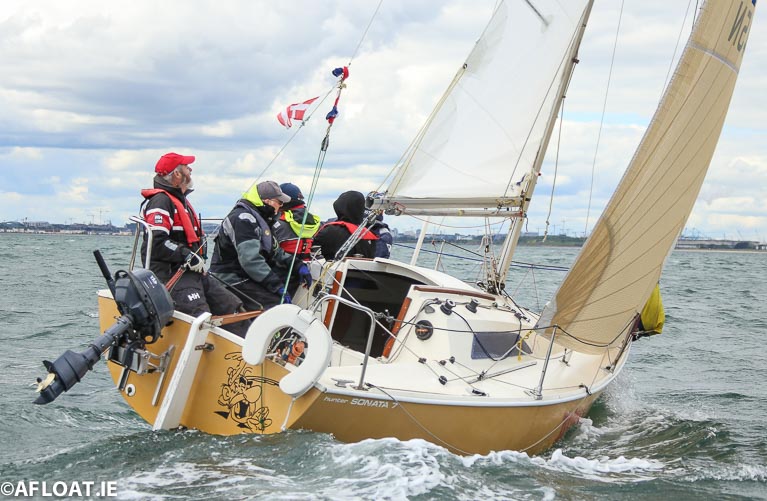 Local boat Asterix (Frazer Meredith & John Counihan) of the DMYC
Local boat Asterix (Frazer Meredith & John Counihan) of the DMYC
Download the class splits below. Read W M Nixon's VDLR 2019 Regatta preview here.
Dun Laoghaire Regatta 2019 Hits 500 Boat Mark
When the starting gun sounds off Dun Laoghaire’s famous harbour on Thursday, Volvo Dun Laoghaire Regatta will not only surpass 2017’s fleet with a fleet this morning of 498 but it is likely to come close to breaking 2007's all time record of 528 entries.
A regatta of this scale brings key benefits to both the sport and the east coast town.
It is a marine tourism boost and one that underpins Dun Laoghaire's place as Ireland’s largest sailing centre and also the venue of one of Ireland’s largest participant sporting events with over 2,500 competitors on the water.
But what’s even more satisfying for the Dun Laoghaire organisers this week is that nearly half the entries for 2019 are visiting boats – an indication of the future international prospects of the regatta.
The 2019 regatta is previewed here by W M Nixon. Sailing Instructions are here and Afloat will carry a review of the 2019 VDLR Runners and Riders when final IRC class splits are published on Monday.
Sailing Instructions for Volvo Dun Laoghaire Regatta 2019 are Published (Download Here!)
Volvo Dun Laoghaire Regatta organisers have published the Sailing Instructions document for Ireland's biggest regatta next month on Dublin Bay.
Five race tracks across Dublin Bay will cater for 2,500 sailors in 480 boats across 34 classes when the first gun sounds on July 11.
The 24-page document contains the official rules and regulations of the regatta as well as the programme of races for the four-day biennial event.
The Sailing Instructions are downloadable below as a PDF file
As Afloat previously reported here, more than 92 different sailing clubs will be represented, including the Channel Islands, Isle of Man, UK, Scotland, Wales, Northern Ireland, from which there are currently 111 entries, and across Ireland.
The fixture is organised jointly by the four Dun Laoghaire waterfront yacht clubs (the Dun Laoghaire Motor Yacht Club (DMYC), the National Yacht Club (NYC), the Royal Irish Yacht Club (RIYC) and the Royal St George Yacht Club (RSGYC).
Conor Fogerty's Foiling Figaro 3 Will Compete at Dun Laoghaire Regatta & is Available for Caribbean Charter Next February
Conor Fogerty's new Figaro 3 keelboat 'Raw' will be the only foiling keelboat racing at Volvo Dun Laoghaire Regatta next month in the former Sailor of the Year's lead up to August's Fastnet Race. After that, the new vessel stars at the Southampton Boat Show before crossing the Atlantic at the end of September where the foiler will be available for charter in the Caribbean this winter.
The debut performance of the foiling Figaro 3 'Raw' from Howth Yacht Club in the Dun Laoghaire Dingle Race has been the start of what Fogerty is calling a 'rather large learning curve'.
Fogerty entered the 280-mile offshore race last week with a three-man crew and he says they were 'happy enough at times during the D2D with her performance'.
The new BJ Marine supplied Beneteau craft powered down the Irish Sea in the east coast stage of the race but he says the crew were frustrated on the south coast from the Tuskar to the Fastnet Rock when they lost their A2 sail and masthead halyard leaving them to white sail the bulk of the race.
Prior to the D2D race, Fogerty revealed he and UK based-Susan Glenny are looking at the foiling venture as an "intent to commit" to becoming Ireland’s reps for the mixed two-person offshore keelboat event for the 2024 Olympics.
The 2017 Irish Sailor of the Year reckons at this early stage that "it will be hard to race to her handicap, but not impossible", although he also notes that IRC has added a further six points to her rating since the D2D. The formula calculation is now 1.124
 Raw Skipper Conor Fogerty (right) with his D2D crew (from right) Laura Dillon, Susan Glenny and Peter Freyne Photo: Afloat
Raw Skipper Conor Fogerty (right) with his D2D crew (from right) Laura Dillon, Susan Glenny and Peter Freyne Photo: Afloat
Fogerty says he will continue the learning curve at July's Volvo Dun Laoghaire Regatta, the ISORA Isle of Man Race leading up to the Fastnet Race.
Raw will then be the showboat at Southampton Boat Show, before heading south for the Canaries and the RORC Transatlantic Race in late September. "She will compete in one of my favourite races, the Caribbean 600" [February 2020].
Fogerty has partnered with LV Yachting to provide race charter in the Caribbean in Raw, with up to six crew spaces for the inshore regatta series. More details on the charter here.
Viking Marine is taking pre-orders for the Official Volvo Dun Laoghaire Regatta Helly Hansen Regatta Clothing. Items ordered by Friday 14th June can have their boat name and sail no screen-printed or embroidered on the gear but get those orders in fast please as the countdown is on.
Jackets, mid-layers, T Shirts and caps are online and in store at the Dun Laoghaire Chandlery.
Order online here




























